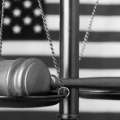( – promoted by navajo)

photo credit: Aaron Huey |
During the 1820s, American miners began to invade the Galena area near the Illinois-Wisconsin border. When the Ho-Chunk began mining lead and selling it to American traders, the government became concerned that the Indians might feel that their land had economic value and might resist giving it to the United States. Thus, the Indian agents were instructed to prevent the Indians from mining lead and selling it. The government’s position was that the Indians must give up this land, along with the lead that it contained, so that it could be properly and profitably developed by the Americans invaders. Tensions increased between the Indians and the Americans.
In 1826 several Ho-Chunk warriors attacked and killed members of a French Canadian family at their sugar camp near Prairie du Chien. The following year, American officials arrested two Ho-Chunk warriors and charged them with the murders. Soon there was a false rumor-possibly started by the Sioux in Minnesota-that the Americans had turned the two prisoners over to the Chippewa for execution. In response to the rumor, the Ho-Chunk tribal council designated Red Bird, Wekau, and Chickhonsic to carry out a revenge raid, a traditional response to the killing of a Winnebago. Red Bird and his two warriors killed a farmer and his hired hand. American settlers in the area responded by asking the government for more troops to protect them.
The actual 1827 Winnebago Uprising really only involved one incident. Two Mississippi keelboats stopped at the Ho-Chunk village above Prairie du Chien after making a delivery to Fort Snelling. One of the boatmen then kidnapped and raped several Ho-Chunk women. In response, Red Bird, as a war chief, organized a war party to rescue the women. Several nights later they caught up with the boats at a narrow stretch of the river near the mouth of the Bad Axe River. The warriors attacked from both shores, from an island, and by canoe. While the Ho-Chunk were unable to capture the boats, the women who were being held captive managed to escape. In the end, four Americans and twelve Ho-Chunk were killed in the battle.
The American settlers were alarmed by the incident and both federal troops and Illinois volunteers were mobilized to put down the “uprising.” They were joined by many miners who simply wanted the Ho-Chunk out of the region so that they could have full access to the lead deposits.
The Ho-Chunk were not unified and a number of prominent Ho-Chunk chiefs sided with the Americans. In the end, and without further battles, Red Bird agreed to give himself up to the military in order to save his people. At the portage between the Fox and Wisconsin rivers, he sang his death song and then surrendered. Carrying a white flag, and accompanied by his relatives, Red Bird entered the American camp. He wore a white buckskin, elaborately fringed, and a two-inch-wide collar of blue which wampum encircled with wildcat claws. Half his face was painted red, the other half green and white, While his surrender was being arranged by the leaders, he mixed tobacco and smoked quietly.
The Americans also arrested six other warriors and charged them with the murders of the farmers and the boatmen.
All of the Ho-Chunk were held in prison. The Ho-Chunk chief Nawkaw went to Washington, D.C. and met with President John Quincy Adams to lobby for Red Bird’s release. While President Adams acquitted Red Bird, the Ho-Chunk war leader died in prison before word of his release reached prison officials. Charges against the four warriors charged in the attack on the keelboats were dropped. Wekau and Chickhonsic were convicted of the murder of the farmer and his hired hand, but were later pardoned.
Red Bird was born near Prairie du Chien, Wisconsin about 1788 and his adult name-Red Bird-came from the red birds that he wore as epaulettes on his shoulders.

Leave a Reply